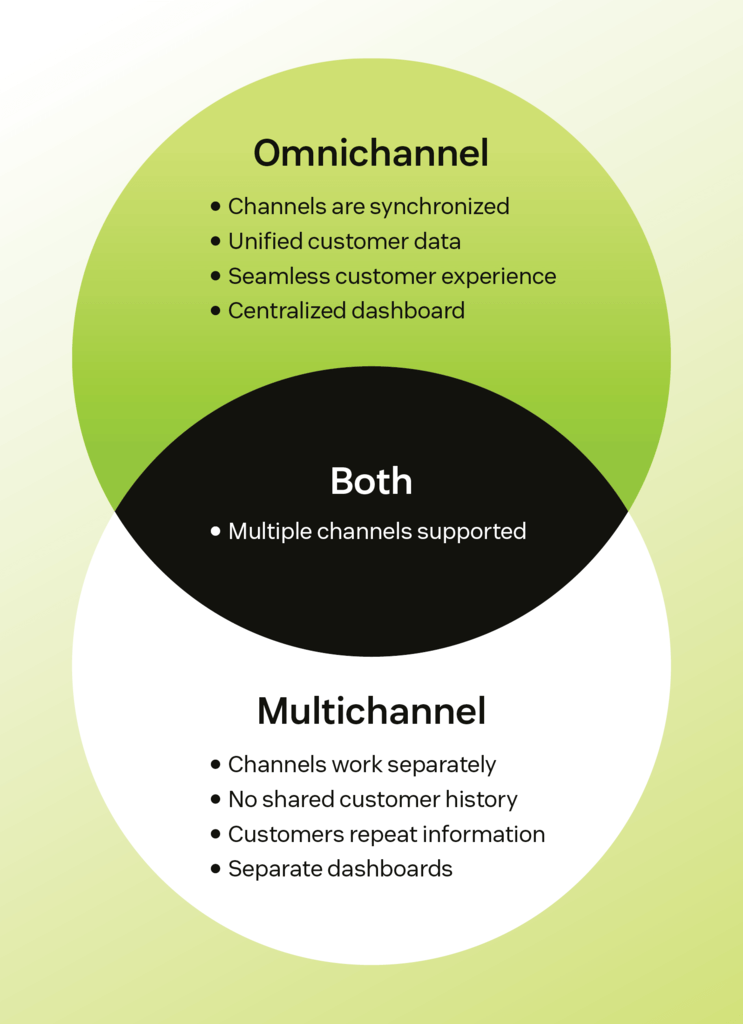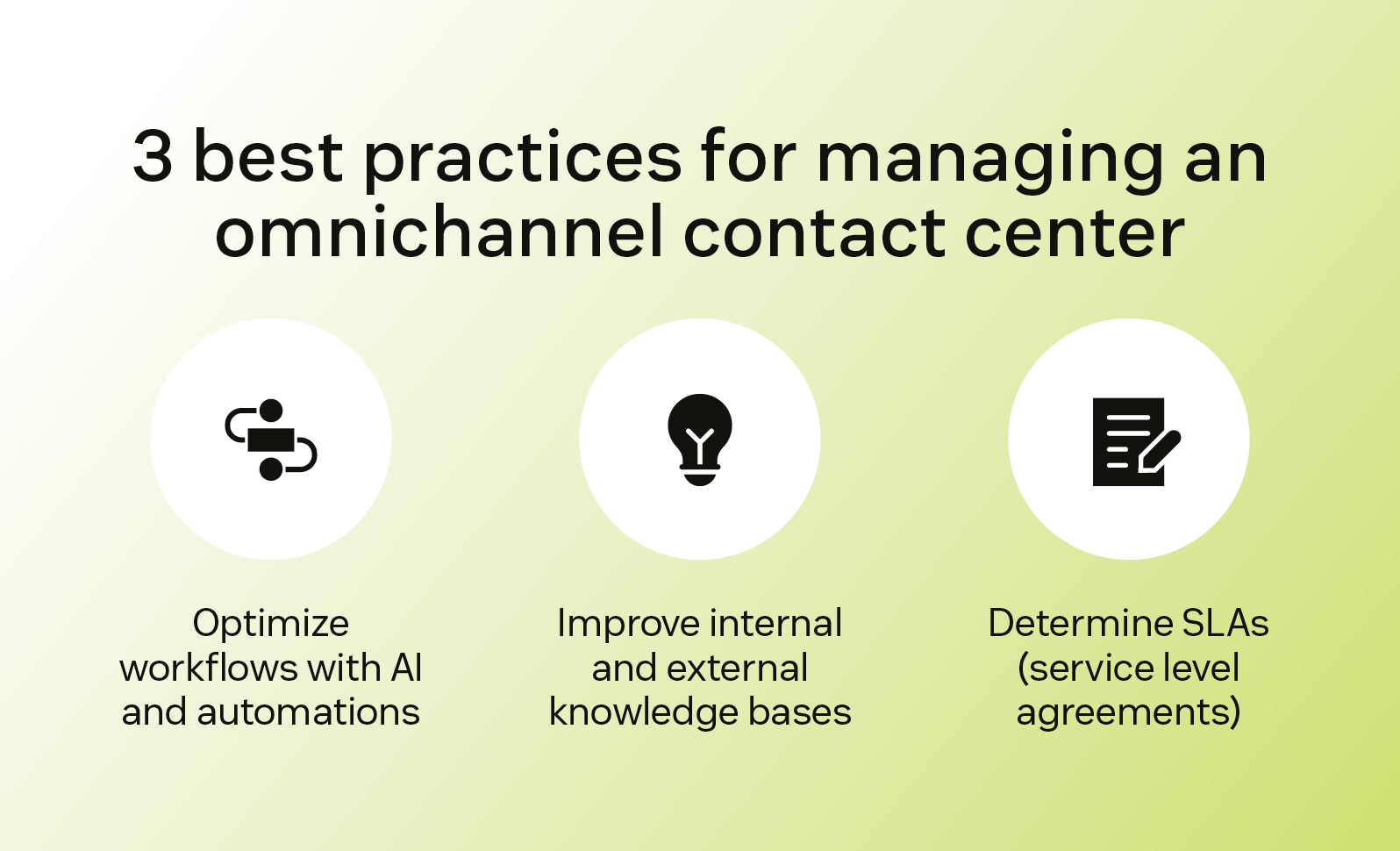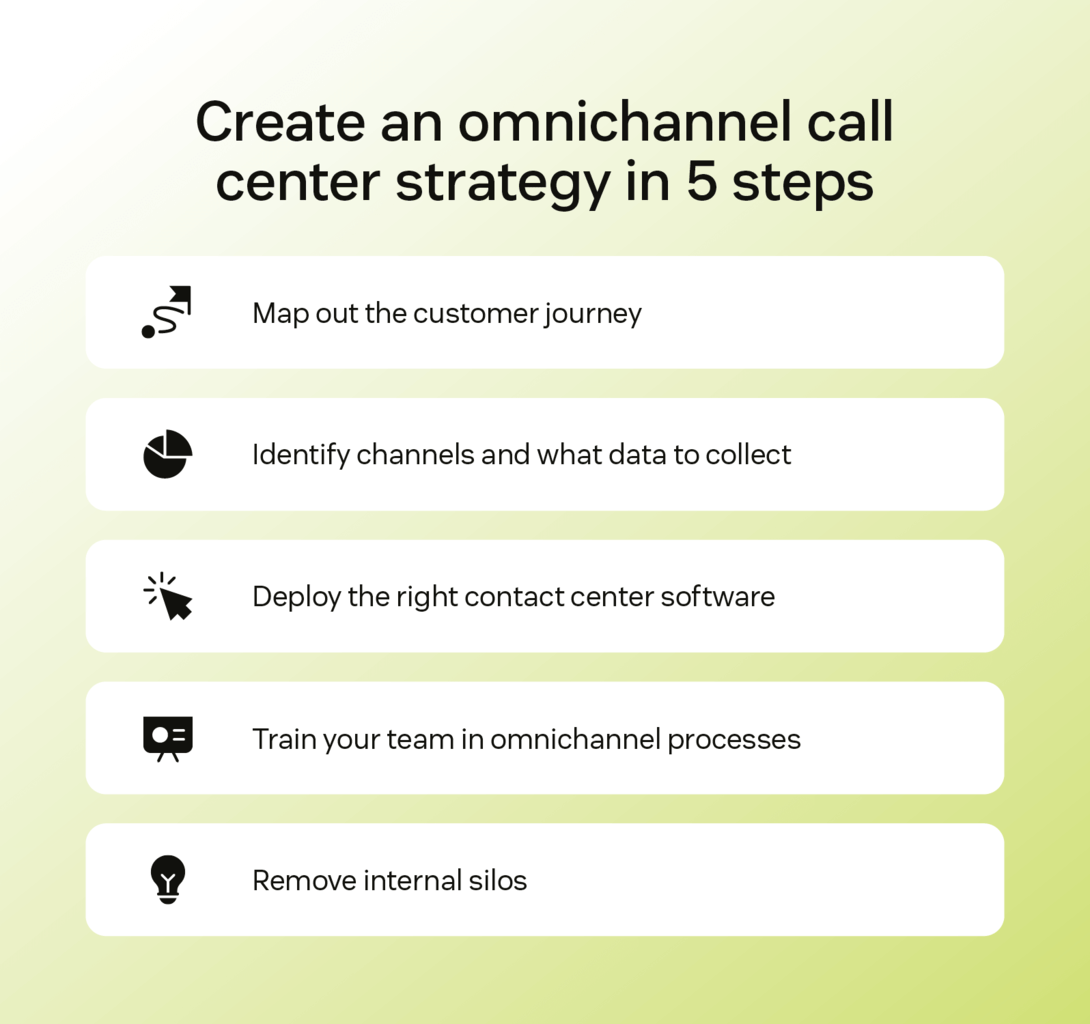Article • 1 min read
What is an omnichannel contact center? A complete guide
Omnichannel contact center software streamlines communication channels so customer service reps can provide consistent and personalized support.
Hannah Wren
Staff Writer
Última actualización en November 18, 2025
Omnichannel contact center definitionAn omnichannel contact center is a customer service approach that synchronizes communication across multiple channels, such as voice, email, SMS, and live chat. With it, support agents gain a complete, unified view of client communication and can provide customers with a seamless, consistent, and personalized experience. |
As modern technology rapidly evolves, customers expect seamless and personalized interactions whenever they reach out for support. Businesses are delivering on these expectations by embracing omnichannel contact centers, which integrate various communication channels into a single interface.
Discover the significance of delivering exceptional customer experiences, and learn how to leverage this approach to stay ahead in competitive markets. Whether you’re a business owner, customer service professional, or curious about the latest trends in customer support, join us as we delve into the potential and benefits of omnichannel contact centers.
More in this guide:
- Omnichannel vs. multichannel contact centers
- Why use an omnichannel contact center?
- Who can benefit from omnichannel contact centers?
- Features of an omnichannel contact center
- Omnichannel contact center best practices
- Implementation steps for an effective omnichannel call center strategy
- Frequently asked questions
- Build a complete omnichannel contact center with Zendesk
Omnichannel vs. multichannel contact centers

Omnichannelcontact centers integrate with backend systems so agents can always access relevant customer information in real time. This unified view of the customer journey allows agents to provide more personalized interactions.
Multichannel contact centers also support multiple channels, but each one operates independently. Unlike omnichannel centers, multichannel interactions aren’t synchronized, so platforms have no continuity.
For example, if a customer follows up on a phone call via email in a multichannel contact center, the responding agent won’t have access to the previous conversation and may ask the customer to repeat themselves. In contrast, an agent in an omnichannel contact center can access the call log and continue the conversation with full context.
Why use an omnichannel contact center?
An omnichannel contact center helps companies meet their customer service objectives by providing seamless support and improving key metrics like response time and satisfaction. Here’s a look at some of the main advantages companies gain after transitioning to omnichannel contact centers.
Improved customer experience
Seventy percent of customers expect anyone they interact with to have full context of their situation, according to Zendesk benchmark data. Omnichannel contact centers make that possible by giving agents a single view of all past interactions, allowing them to respond more accurately and efficiently. This helps customers feel heard and eliminates the need to repeat themselves, creating a more connected and satisfying experience.
Boosted agent efficiency
Omnichannel contact centers streamline agent workflows by centralizing customer data, conversation history, and channel activity into a single workspace. This saves agents from switching between platforms or searching through past conversations, saving time and shortening resolution time.
When combined with AI customer service tools, these workflows become even more efficient, helping handle more inquiries in less time.
Decreased customer churn
According to Zendesk benchmark data, 73 percent of customers move to a company’s competitor after multiple bad experiences. Omnichannel communication empowers agents to provide higher-caliber service, which can increase customer satisfaction and retention.
It also leads to smoother, more convenient support experiences, and when you meet customers’ needs and expectations, they have fewer reasons to leave your company.
Increased personalization
Customer information is key to providing great service, and with omnichannel contact centers, support agents have that valuable information at their fingertips. Reps can readily see customer profiles and conversation history, so they’re armed with the data they need to personalize the current interaction. This also means agents don’t need to rely on a generic call centerscript to assess the situation.
Who can benefit from omnichannel contact centers?
Omnichannel contact centers are built to support businesses of all sizes. Because they’re designed to scale, these platforms make it easy to add new channels and give agents the tools they need to keep up with rising demand.
This approach is especially valuable for:
- Retail and e-commerce brands, where customers move between browsing, purchasing, and post-sale support across devices and channels
- Travel and hospitality businesses, which must manage time-sensitive requests and changes across channels
- Healthcare and financial services, where customers expect secure, consistent service across multiple touchpoints
Ultimately, omnichannel support benefits any customer-oriented business that values loyalty and long-term growth.
Features of an omnichannel contact center
Omnichannel contact centers help employees perform to the best of their abilities to provide high-quality customer service. The features that will have the greatest impact on your contact center operations are accessed through omnichannel software.
Here are some features that help contact centers provide superior service over competitors that stick to traditional methods.
AI and automation
In an omnichannel setup, AI tools can automatically route tickets to the right agent, summarize conversations, detect customer intent, and suggest relevant responses in real time.
At the same time, automation handles repetitive tasks, reducing manual work and speeding up resolution times. Together, these capabilities improve efficiency while ensuring customers get responsive support no matter how they reach out.
Inbound and outbound calls
Whether your business specializes in inbound or outbound communication, omnichannel contact center solutions can support both. The software integrates with customer relationship management (CRM) platforms so agents always have access to relevant customer data. Inbound calls can automatically transfer from an agent’s desk phone to their mobile device.
Channel visibility
Quickly responding to customers is a common challenge for agents managing multiple communication channels. Questions and comments can fall through the cracks, and moving between platforms is time-consuming.
Omnichannel contact center software improves agent productivity by providing a centralized dashboard to work from. Agents can stay organized and effective whether they’re working over the phone, on social media, or via SMS. Managers can also get a bird’s-eye view of agent activity to stay informed on conversation progress and success.
Workforce optimization
An omnichannel contact center solution helps with workforce management by monitoring agent availability and workloads in real time, ultimately preventing employee burnout. The technology can also aid resource allocation by analyzing demand patterns to ensure you evenly distribute your staff to meet performance standards.
Omnichannel contact center best practices
Even after establishing an omnichannel contact center strategy, you’ll need to carefully manage operations so everything runs smoothly. Here are some best practices to keep your customers and employees happy.
Optimize workflows with AI and automations
AI and automations play an important role in omnichannel communication by assisting employees with their tasks and customers with their requests.
See a few ways you can use this technology to optimize workflows:
- Intelligent skills-based routing: AI-powered systems can analyze customer queries and automatically direct them to the appropriate agent using omnichannel routing strategies.
- Bots and virtual assistants: Automated systems use natural language processing and machine learning to provide instant responses and useful resources.
- Predictive analytics: AI algorithms can anticipate customer needs based on patterns, enabling employees to proactively personalize recommendations and deliver targeted service.
Companies can streamline processes by leveraging AI and automation to deliver better customer experiences.
Improve internal and external knowledge bases
An internal knowledge base is your employees’ point of reference when resolving customer issues. It should include a comprehensive library of information that employees can quickly search through to find answers while interacting with customers. This improves employee effectiveness and reduces the need to involve senior team members to reach a successful resolution.
An external knowledge base serves a similar role but is intended for customer self-service. These are easily shareable resources, like articles or how-to videos, that employees can direct customers to during their interactions. When employees can share this information publicly, they’ll spend less time walking customers through each step of a task.
Determine service level agreements (SLAs)
A service level agreement (SLA) is a contract that outlines standards for customer support. For a contact center, an SLA includes things like:
Response times
Average handling times
Resolution rates
As omnichannel communication improves agent performance, consider adjusting your SLAs to reflect your new capabilities. Your SLAs should be realistic while keeping you competitive in your industry.

Implementation steps for an effective omnichannel call center strategy
Using omnichannel contact center software can only get you so far if you don’t have a plan of action. Here are five steps to create an effective omnichannel call center strategy.
1. Map out the customer journey
A customer journey map is a blueprint of the steps a customer takes when interacting with your company. It should include each touchpoint and provide context for what the customer is experiencing.
According to Zendesk benchmark data, 71 percent of business leaders plan to revamp their current customer journey to provide more immersive experiences. This can be a serious undertaking, but it’s necessary to ensure your business delivers modern interactions that live up to customer expectations.
2. Identify which channels to use and what data to collect
Providing customers with multiple methods of communication is one of the primary objectives of an omnichannel strategy. Your customer base likely has preferred support channels, so focus your efforts on where you can best serve them.
Approach data collection similarly. Identify which call center metrics are most relevant to your goals. These may include:
Average resolution time
- First contact resolution rate
Customer satisfaction (CSAT) score
Determine what data to collect early on to accurately measure if you’re achieving the desired results.
3. Deploy the right contact center software
The success of your omnichannel initiatives will largely hinge on the software you choose. Omnichannel contact center platforms offer a variety of tools depending on the provider. Some of these tools will be essential to your performance, so pick software that provides and performs them well.
Some essential tools include:
- Interactive voice response (IVR)
Analytics and reporting
Third-party integrations
4. Train your team in omnichannel processes
Whenever you shake up the status quo, your team will need to adjust to new processes and learn how to use the new software to its fullest capabilities. Switching to a new system will change how your team monitors channels, manages tickets, and collaborates on tasks. If you don’t take the time to train call center agents, they’ll be slow to adopt new tools and fall back on old ways.
Educate the team on how the:
Customer journey is changing
New strategy impacts them and their role
- Process ties into any new call center skills they might need
This will also set you up to receive productive feedback from your employees about how to further improve these processes.
5. Remove internal silos
An omnichannel approach improves access to customer information, but fully removing internal data silos still requires cooperation between departments. Sales, marketing, and customer service must work together to share information so team members have a complete customer view. Businesses can’t flourish if departments hoard data.

Frequently asked questions
Build a complete omnichannel contact center with Zendesk
As customer expectations grow more complex, companies need technology that keeps pace. Omnichannel contact centers powered by AI and automation help teams respond quickly and thoughtfully across every channel, giving customers a consistent, high-quality experience.
Zendesk brings these capabilities together in one place, making it easier to manage conversations and strengthen customer relationships at scale. Learn more about our contact center solution and see how Zendesk can help you deliver more impactful customer experiences.
